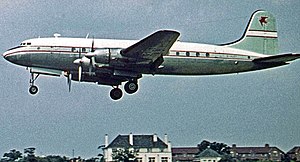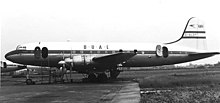Handley Page Hermes
| HP.81 Hermes | |
|---|---|

| |
| Hermes IV of Air Safaris at Manchester Airport in 1961 | |
| Role | Airliner |
| Manufacturer | Handley Page |
| First flight | 2 December 1945 |
| Introduction | 6 August 1950 |
| Primary user | BOAC |
| Produced | 1945–1951 |
| Number built | 29 |
| Developed from | Handley Page Hastings |
The Handley Page HP.81 Hermes was a British civilian airliner built by Handley Page in the 1940s and 1950s. Closely related to Handley Page's Hastings military transport, the Hermes was a low-wing monoplane powered by four piston engines. Twenty-nine were built, serving briefly with BOAC in the early 1950s and later with several charter airlines.
Design and development[]
The Hermes was built to meet the 1944 Air Ministry specification for a pressurised civil transport capable of carrying 34 first-class or 50 tourist-class passengers, at the same time as the RAF required a new transport to replace its Handley Page Halifax, for which Handley Page designed the very similar Handley Page Hastings.[1] Unlike the tailwheel Hastings, the Hermes was planned to have a nosewheel undercarriage, although the first two prototypes used a tailwheel undercarriage, of which the first was an unpressurised "bare shell" and the second to be pressurised and fully equipped.[2] It was intended to introduce the Hermes before the Hastings, but production was delayed after the first prototype (HP 68 Hermes 1), registered G-AGSS crashed on its maiden flight shortly after takeoff on 2 December 1945.[3] Handley Page's chief test pilot and the chief test observer were both killed.[4]
Development of the civil Hermes was delayed to resolve the instability that caused the accident to the first prototype, and the chance was taken to lengthen the second prototype, producing the HP 74 Hermes II (G-AGUB), first flying on 2 September 1947.[1]
Meanwhile, orders were placed on 4 February 1947 for 25 of the definitive HP 81 Hermes IV, fitted with a tricycle undercarriage and powered by 2,100 hp (1,570 kW) Bristol Hercules 763 engines, for BOAC and two HP Hermes V, powered by the Bristol Theseus turboprop engines.[5]
Operational history[]
Airline operations[]


While the first Hermes IV (registered G-AKFP) flew on 5 September 1948,[1] and production built up quickly, the early aircraft were overweight, partly due to the use of Hastings components, and were initially rejected by BOAC.[6]
The Hermes IV finally entered service with BOAC on 6 August 1950, taking over from the Avro York on the West Africa service from London Heathrow to Accra via Tripoli, Kano and Lagos, with services to Kenya and South Africa commencing before the end of the year.[7] The Hermes IV was used by BOAC on routes to West and South Africa. They were quickly replaced, however by the reliable Canadair Argonaut in 1952, although some re-entered service in July 1954 following the grounding of the de Havilland Comet, being retired again in December.[8]
This was not the end of the Hermes in airline service, however, as surplus aircraft were sold to independent charter airlines, with Airwork purchasing four in 1952, others being operated by Britavia and Skyways, particularly in the trooping role.[9] Many of these aircraft were fitted with Hercules 773 engines which could run on lower octane fuel than the original Hercules 763s, being designated as Hermes IVA, returning to Hermes IV standards when fuel supplies improved.[9]
Later, the Hermes were flown on inclusive tour holiday flights from the UK. The last Hermes, G-ALDA, flown by Air Links Limited, was retired on 13 December 1964, and was scrapped nine days later.[10]
Development aircraft[]

The two turboprop Hermes V were owned by the Ministry of Supply and made their first flights in August 1949. They were used for development of the Bristol Theseus turboprop engine. The first was lost in a wheels-up landing at Chilbolton airfield on 10 April 1951, but the second continued development flying with the A&AEE at Boscombe Down and the RAE at Farnborough until retirement in September 1953.
The prototype Hermes II was given military markings in October 1953 as VX234 and was used for various research and development programmes, including the testing of airborne radar for the Royal Radar Establishment at RAF Defford, Worcestershire, being finally retired in 1969, the last of the Hermes.[11]
The fuselage of a Hermes IV (the former BOAC aircraft G-ALDG named Horsa) is preserved at the Imperial War Museum Duxford.
Variants[]
All 29 aircraft were built at Radlett Aerodrome, Hertfordshire, England.
- HP.68 Hermes I
- Prototype powered by four 1,650 hp (1,230 kW) Bristol Hercules 101 radial engines. One built.
- HP.74 Hermes II
- Prototype powered by four 1,675 hp (1,249 kW) Bristol Hercules 121 engines and a 13 ft (4.57 m) longer forward fuselage. One built.
- HP.81 Hermes IV
- Production aircraft with tricycle landing gear, powered by four 2,100 hp (1,570 kW) Bristol Hercules 763 engines. Twenty-five built.
- HP.81 Hermes IVa
- Hermes IV modified to use 100-octane fuel, with the engine redesignated Hercules 773. Most converted back to Hermes IV standard.
- HP.82 Hermes V
- Development aircraft with four 2,490 hp (1,860 kW) Bristol Theseus 502 turboprops. Two built.
Operators[]
- Air Safaris
- Airwork
- Britavia
- British Overseas Airways Corporation
- Falcon Airways
- Royal Radar Establishment
- Silver City Airways
- Skyways
- Ministry of Supply
Accidents and incidents[]
- 3 December 1945 - Hermes I G-AGSS the prototype Hermes crashed on the first test flight soon after takeoff three miles from Radlett Aerodrome. The two Handley Page test pilots were killed.
- 26 May 1952 - Hermes IV G-ALDN (Horus), operated by BOAC, en route from Tripoli, Libya, to Kano, Nigeria, flew off course for several hours and ran out of fuel, force landing in the Sahara Desert south of Atar, Mauritania. The passengers and crew all survived and spent several days in the desert before making their way to an oasis, where First Officer Ted Haslam, who had suffered a head injury in the crash, died.[12][13]
- 4 March 1956 - Hermes IV G-ALDW operated by Skyways Limited was destroyed on the ground by a time-bomb in the forward freight compartment. The aircraft was at Nicosia Airport, Cyprus when the explosion occurred 20 minutes before the aircraft was due to depart for the United Kingdom with 68 passengers.[14] There were no fatalities.[15]
- 5 August 1956 - Hermes IV G-ALDK operated by Britavia suffered the collapse of the nose undercarriage at Drigh Road Airport, Karachi, Pakistan. The aircraft was damaged beyond economic repair.[16]
- 5 November 1956 - Hermes IVa G-ALDJ operated by Britavia crashed on night approach to Blackbushe Aerodrome, England in bad weather. Seven of the 80 occupants died.[17]
- 1 April 1958 Hermes IV G-ALDV operated by Skyways Limited. Crashed at Meesden Green, close to Stansted Airport, whilst on an airtest after an engine change. The crew of three, Capt. Rayment, Capt. West and FE. N Bradley were all killed.
- 9 October 1960 - Hermes IV G-ALDC of Falcon Airways overran the runway on landing at Southend Airport, ending up across the Shenfield to Southend railway line. The aircraft was written off but all 76 people on board survived.[18]
Specifications (Hermes IV)[]

Data from Jane's All the World's Aircraft 1950-51[19]
General characteristics
- Crew: 5 flight crew + cabin crew
- Capacity: 40 - 82 passengers
- Length: 96 ft 10 in (29.51 m)
- Wingspan: 113 ft (34 m)
- Height: 29 ft 11 in (9.12 m)
- Wing area: 1,408 sq ft (130.8 m2)
- Airfoil: root: NACA 23021; tip: NACA 23007[20]
- Empty weight: 55,350 lb (25,106 kg) basic equipped
- Max takeoff weight: 82,000 lb (37,195 kg)
- Maximum landing weight: 75,000 lb (34,019 kg)
- Fuel capacity: 3,224 imp gal (3,872 US gal; 14,657 l) in integral wing tanks ; 4x 37 imp gal (44 US gal; 168 l) oil tanks
- Powerplant: 4 × Bristol Hercules 763 14-cylinder air-cooled radial piston engines, 2,020 hp (1,510 kW) each for take-off
- Propellers: 4-bladed de Havilland Hydromatic, 13 ft (4.0 m) diameter constant-speed fully-feathering reversible-pitch propellers
Performance
- Maximum speed: 357 mph (575 km/h, 310 kn) at 20,000 ft (6,096 m)
- Cruise speed: 266 mph (428 km/h, 231 kn) maximum weak mixture at 10,000 ft (3,048 m)
- 274 mph (238 kn; 441 km/h) maximum weak mixture at 20,000 ft (6,096 m)
- 213 mph (185 kn; 343 km/h) maximum range speed at 10,000 ft (3,048 m)
- 244 mph (212 kn; 393 km/h) maximum range speed at 20,000 ft (6,096 m)
- Range: 3,147–3,554 mi (5,065–5,720 km, 2,735–3,088 nmi) with 2,213 lb (1,004 kg) payload at 20,000 ft (6,096 m) dependent on speed
- Service ceiling: 24,500 ft (7,500 m)
- Rate of climb: 1,030 ft/min (5.2 m/s)
- Time to altitude:
- 10,000 ft (3,048 m) in 10 minutes 30 seconds
- 20,000 ft (6,096 m) in 25 minutes
- Wing loading: 58.2 lb/sq ft (284 kg/m2)
- Power/mass: 0.104 hp/lb (0.171 kW/kg)
- Take-off run: 3,330 ft (1,015 m) at 82,000 lb (37,195 kg)
- Take-off distance to 50 ft (15 m): 4,440 ft (1,353 m)
- Landing distance from 50 ft (15 m): 4,224 ft (1,287 m)
See also[]
Related development
Aircraft of comparable role, configuration, and era
References[]
- ^ Jump up to: a b c Jackson 1973, p.247.
- ^ Barnes 1976, pp.437–437.
- ^ Barnes 1976, p437.
- ^ "Loss of the prototype Hermes" Flight 6 December 1945.
- ^ Barnes 1976, p.461.
- ^ Barnes 1976, p.465.
- ^ Jackson 1973, p.248–249.
- ^ Jackson 1973, p.249.
- ^ Jump up to: a b Jackson 1973, p.249–250.
- ^ Jackson 1973, p.251.
- ^ Barnes 1976, pp.473–474.
- ^ Fisher, John Hayes (Producer). (2003). Desert Rescue [Television series episode]. In Meet the ancestors. London: British Broadcasting Corporation.
- ^ Magna, April 2014, the magazine of the Friends of The National Archives, London.
- ^ "Civil Aviation: Hermes Sabotage". Flight. 16 March 1956, p.306.
- ^ "ASN Aircraft accident Handley Page HP.81 Hermes IV G-ALDW Nicosia". Aviation Safety Network. 26 October 2014. Retrieved 26 October 2014.
- ^ Chesterfield, Lyn. "Hermes prang". Aeroplane. No. January 2011. Kelsey Publishing. p. 82.
- ^ ICAO Accident Digest No.8, Circular 54-AN/49 (138–147)
- ^ "G-ALDC Accident description". Aviation Safety Network. Retrieved 22 March 2011.
- ^ Bridgman, Leonard, ed. (1950). Jane's All the World's Aircraft 1950-51. London: Sampson Low, Marston & Co. p. 65c.
- ^ Lednicer, David. "The Incomplete Guide to Airfoil Usage". m-selig.ae.illinois.edu. Retrieved 16 April 2019.
Bibliography[]
- Barnes, C. H. Handley Page Aircraft Since 1907. London: Putnam, 1976. ISBN 0-370-00030-7.
- Barnes, C. H. Handley Page Aircraft Since 1907. London: Putnam & Company, Ltd., 1987. ISBN 0-85177-803-8.
- Clayton, Donald C. Handley Page, an Aircraft Album. Shepperton, Surrey, UK: Ian Allan Ltd., 1969. ISBN 0-7110-0094-8.
- Jackson, A.J. British Civil Aircraft since 1919: Volume 2. London:Putnam, Second edition 1973. ISBN 0-370-10010-7.
Further reading[]
- Donald, David (1997). The encyclopedia of world aircraft (Updated ed.). Leicester: Blitz Editions. p. 496. ISBN 1-85605-375-X.
External links[]
| Wikimedia Commons has media related to Handley Page Hermes. |
- Hastings at British Aircraft Directory (archive.org copy)
- Hermes (archive.org copy)
- A picture of the Hermes II prototype G-AGUB - (note: picture file name is misidentified as an Avro Tudor II) (archive.org copy)
- 1940s British airliners
- Handley Page aircraft
- Four-engined tractor aircraft
- Low-wing aircraft
- Aircraft first flown in 1945
- Four-engined piston aircraft